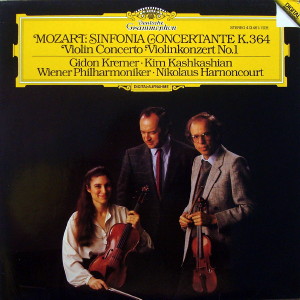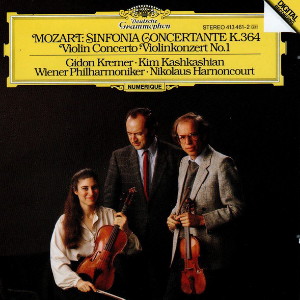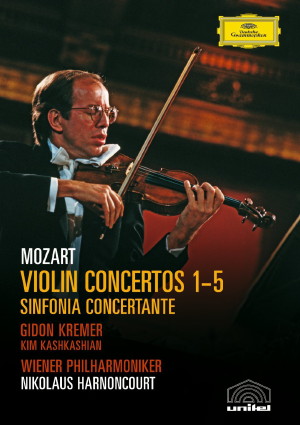 |
1 LP -
413 461-1 - (p) 1984
|
 |
| 1 CD -
413-461-2 - (p) 1984 |
 |
| 2 DVD -
0440 073 4157 5 - (c) 2006 |
|
| Wolfgang
Amadeus Mozart (1756-1791) |
|
|
|
|
|
|
|
| Sinfonia concertante Es-dur,
KV 364 (320d) |
|
31' 31" |
|
- Allegro maestoso
|
13' 56" |
|
A1
|
- Andante
|
11' 06" |
|
A2
|
- Presto
|
6' 29" |
|
A3
|
Konzert
für Violine und Orchester Nr. 1 B-dur,
KV 207
|
|
25' 17" |
|
- Allegro moderato
|
7' 06" |
|
B1
|
| - Adagio |
9' 53" |
|
B2
|
| - Presto |
6' 18" |
|
B3
|
|
|
|
|
| Gidon
Kremer, Violine |
|
| Kim
Kashkashian, Viola |
|
|
|
| WIENER
PHILHARMONIKER |
|
| Nikolaus
Harnoncourt, Dirigent |
|
|
Luogo
e data di registrazione
|
| Grosser
Saal, Musikverein, Vienna (Austria) -
ottobre 1983 |
|
Registrazione
live / studio
|
| studio |
Producer
/ Engineer
|
Hanno
Rinke / Co-production with UNITEL
|
Prima Edizione CD
|
| Deutsche
Grammophon - 413 461-2 - (1 cd) - 55'
09" - (p) 1984 - DDD |
Prima
Edizione LP
|
Deutsche
Grammophon - 416 461-1 - (1
lp) - 55'
09"
- (p) 1984
- Digital
|
Edizione
DVD
|
| Deutsche Grammophon - 0440 073
4157 5 - (2 dvd) - 92" 00" + 61' 00" -
(c) 2006 - GB |
|
|
Notes
|
You
yourself do not realize
how well you play the violin..." wrote
Leopold Mozart to his
son in 1777. Did Wolfgang Amadeus
compose his five
violin Concertos for himself, for his
colleague Antonio Brunetti, the leader
of the Salzburg
orchestra, or for a friend
of the family? We do
not know. The first Concerto, K.
207, was completed “à
Salisburgo li 14 di Aprile l773".
This work is straightforward in style.
with little motivic elaboration or polyphonie
writing, The two oboes
are only occasionally separated from the
violins, as in the Finale, while the
horns are introduced solely to add
sonority. This is, however, an
altogether charming and agreeable solo
concerto, rewarding for
the soloist. It
belongs to the Rococo style of the
transition from the Baroque age to
that of Classicism. The
Allegro moderato with its "sighing"
figures on the
strong beats of the bar and its proud,
syncopated minims
(half-notes) in the principal theme is
clearly a product of the "galant”
style, and when in the Adagio a
beautiful melody soars high above the
zephyr-like murmuring
of the secand violin
semlquavers (16th-notes), the young
composer has adopted the “empfindsamer
Stil", the other idiom of that time,
with its emphasis on tender feeling.
The Presto scampers by
with sprightly grace, interrupted by
vigorous passages in unison. The solo
violin plays high
above the sparse accompanying texture,
often of repeated quavers
(eighth-notes). In the soloist's
long chains of senuquavers and
triplets Mozart pays tribute to such
earlier violinist composers as Pugnani
and Nardini, while the cantabile
element, never neglected even
during running passages, is the fruit
of the training received from his
father: “He plays something difficult,
hut one does not recognize that it is
difficult... and so it should be", he
wrote about a
violinist of the Mannheim orchestra.
The genre of the “coneertante
symphony” originated in
Paris, and was cultivated further in
the musical hothouse of the princely
court at Mannheim - in
fact Mozart wrote his first
“Concertante" in
Paris for Mannheim musicians. This
genre flowered fully in the Sinfonia
Concertante K. 364
(320d) which he composed at Salzburg
in
the late summer of l779. From the many
cornbinations of solo
instruments which may be
contrasted with the full orchestra,
Mozart chose the one most popular in
his native Salzburg: violin and viola.
He specified that the viola was to be
tuned a semitone higher than usual
(“accordatura un mezzo
tono più alto”) and
wrote its part in D, not in order to
make the part easier to play (open
strings!) but to bring
the tone of the viola closer to that
of the more brilliant violin,
producing a better partnership between
the two soloists and clearly
separating the alto instrument from
the tutti. The extent and weight of
the orchestral introduction give this
work a symphonic character, clearly
diiferentiating it from the sociable
nature of earlier solo concertos.
Following the profound experiences of
Mannheim and Paris, the young Mozart’s
days of carefree creative work along
conventional lines were over. The
Sinfonia Concertante,
a pinnacle among his concertos,
already anticipates the maturity of
the late piano concertos
which Mozart wrote in Vienna. Laughter
amid tears, profound understanding of
human nature - these underlie the
self-confidence of the Allegro
rnaestoso, the quiet serenity of the
Andante, and the exuberance of the
rondo-form Presto.
Roland Würtz
Translation: John
Coombs
|
|
Nikolaus
Harnoncourt (1929-2016)
|

|

|
|